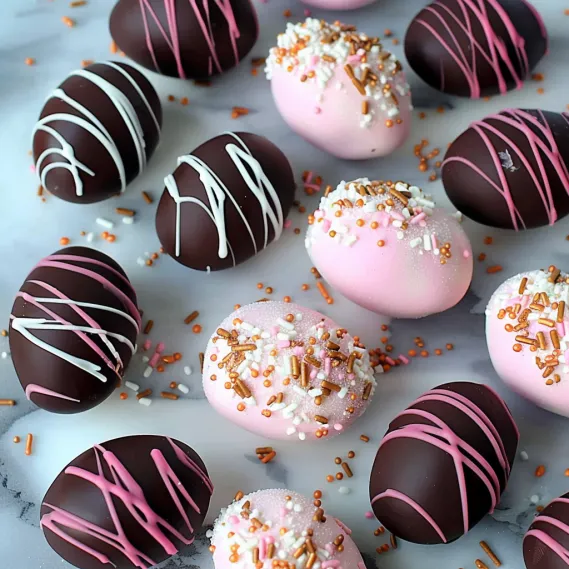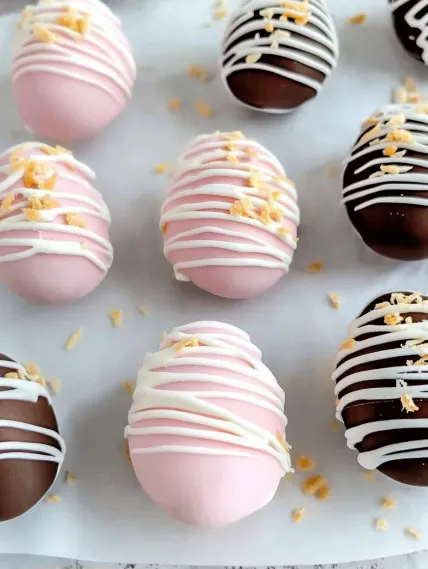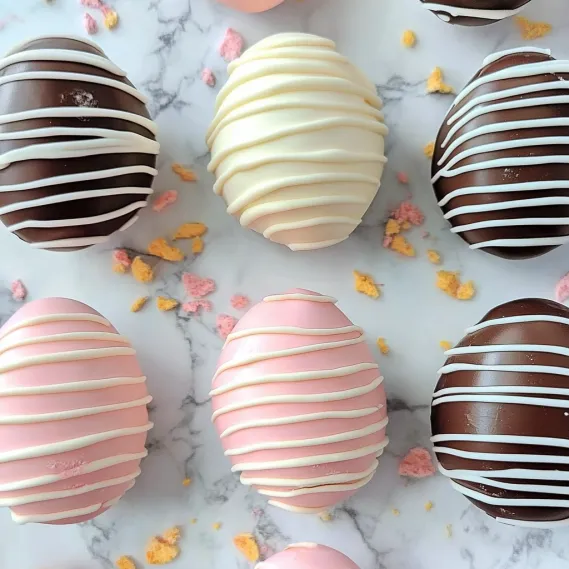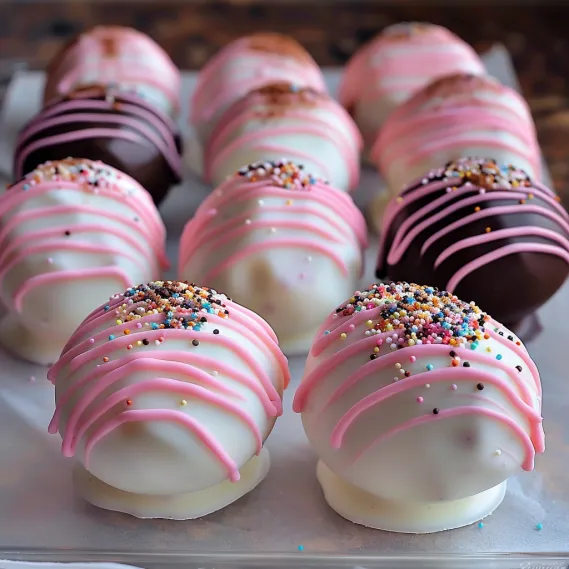 Pin it
Pin it
Nothing beats sinking your teeth into a chocolate-coated marshmallow Easter egg you've made yourself. That perfect mix of fluffy, light marshmallow inside with the crisp chocolate shell outside makes for a treat that completely transforms regular Easter goodies. My first try at these cute eggs left me wondering – would making marshmallows from scratch be worth all the work? I can tell you now, absolutely! These puffy treats don't even compare to what you'd buy at the store, with their cloud-like softness and fresh vanilla taste that you just can't turn down.
We first whipped these up with my kids last Easter, and they couldn't believe their eyes as basic ingredients turned into something almost magical. My little one, who usually stays away from anything sticky, gladly dug his hands in once he realized we were basically playing with fluffy edible clouds. Even my teen, who tries so hard to seem unimpressed by everything, couldn't help getting involved – especially when it came time to coat everything in chocolate.
Key Ingredients and Shopping Advice
- Unflavored Gelatin: Try to get Knox brand from the baking section, typically in small boxes with four packets. Each packet has around 2.5 teaspoons of gelatin
- Granulated Sugar: Standard white sugar gives the right sweetness and feel. Don't try using sugar substitutes as they'll mess up how your marshmallows form
- Light Corn Syrup: This stops sugar crystals from forming while cooking, giving you that classic marshmallow bounce. Don't worry – you won't taste it in the finished eggs
- High-Quality Chocolate: Spend a bit more here, like Ghirardelli dark or semisweet baking bars. Better chocolate means your eggs will taste amazing
The real showstopper in this recipe has to be the homemade marshmallow. When I finally tried making them and tasted that fresh, fluffy goodness, I kicked myself for not trying it sooner. The texture's out of this world – it's like taking a bite of a sweet, vanilla-kissed cloud.
Step-By-Step Making Instructions
- Step 1: Shape Your Egg Molds
- Pour all-purpose flour into a 9x13-inch dish and smooth it flat with a spoon or spatula. Push a plastic Easter egg halfway down into the flour to make perfect egg shapes, keeping them about an inch apart so they're easy to remove. If flour sticks to your hands, dust them with some powdered sugar while you work.
- Step 2: Cook Your Sugar Mix
- Sprinkle gelatin over cold water in your mixer bowl and let it soak while you handle the next part. Mix sugar, corn syrup, salt and water in a pot and heat without stirring until it hits exactly 240°F (soft-ball stage). Take it off the heat right away when it reaches that temp so the sugar doesn't turn brown.
- Step 3: Beat the Marshmallow Until Fluffy
- Starting your mixer on low, slowly pour the hot sugar mix into the soaked gelatin in one steady stream. Gradually turn the speed up to high and keep beating for 12-15 minutes until everything gets thick, white, and grows to three times its size. Add some vanilla during the last minute of mixing for the best taste.
- Step 4: Fill Your Molds and Wait
- Put the marshmallow mix into a piping bag or plastic baggie with a corner cut off and quickly fill the flour molds before it starts setting. Make sure each mold is full, and use a wet fingertip to smooth the tops if needed. Let the marshmallows sit uncovered at room temp for at least 3 hours or overnight until they're firm.
- Step 5: Dust Off and Dip in Chocolate
- Carefully take the set marshmallows out of the flour, brush off extra flour with a soft brush, then coat them with a mix of cornstarch and powdered sugar. Melt good chocolate using a double boiler or microwave, then dunk each marshmallow egg completely, tap off extra chocolate and place on parchment to harden. Add sprinkles while the chocolate's still wet, then let everything set fully before serving.
 Pin it
Pin it
My first go at these eggs taught me some big lessons about not rushing things. I hurried through the piping and ended up with marshmallow strings all over my kitchen like festive spider webs. Now I get everything ready before the marshmallow's done and work carefully but quickly when it's time to fill those molds.
Tasty Presentation Ideas
These chocolate marshmallow eggs look fantastic in Easter baskets, but you can show them off in so many other ways too. Put them on a pretty plate with fake grass made from green-tinted shredded coconut. For a spring get-together, try using one at each person's spot as an edible name card by tying on a small tag with light-colored ribbon. They also make great gifts when packed in clear bags tied up with pretty ribbons.
Fun Twist Options
The standard vanilla marshmallow with chocolate outside tastes amazing, but you can switch things up in tons of ways. Try adding a touch of mint or almond flavoring to your marshmallow, or swap out vanilla for strawberry or orange for fruity eggs. The chocolate coating gives you another chance to get creative – maybe use white chocolate colored light pastel shades, or drizzle different colored chocolate on top. For a fancier look, add royal icing flowers or draw patterns with colored white chocolate.
 Pin it
Pin it
Keeping Them Fresh
These marshmallow eggs stay good for up to two weeks when stored right. Put them in an airtight container with parchment paper between layers so they don't stick together. Keep them at cool room temperature instead of in the fridge, since chilling can make the chocolate get damp and sticky when brought back to room temp. If you're giving them as gifts, wrap single eggs in clear bags tied with pastel ribbons, or arrange several in pretty Easter boxes lined with colored tissue.
 Pin it
Pin it
What started as just trying something new has turned into one of our favorite Easter activities. There's something really rewarding about taking simple ingredients and making these fancy-looking treats that make everyone so happy. The making process itself becomes a special part of our holiday – flour-covered faces, sticky hands, and all. While they might look hard to make at first glance, these homemade marshmallow Easter eggs are actually pretty doable even for beginners, and the end result makes all the effort worthwhile.
Frequently Asked Questions
- → Can I skip corn syrup when making these?
- Corn syrup is what makes the marshmallows smooth and avoids sugar crystals forming. You can swap it for honey or golden syrup, but it will slightly change the marshmallow's flavor and texture. Stick to the same quantity. In a pinch, you could also try homemade invert sugar, but it requires an extra step and precision.
- → Is a candy thermometer necessary?
- Yes, it's highly recommended. Getting the sugar syrup up to 240°F (soft ball stage) ensures you get pillowy marshmallows. Without one, you can try the cold water method—drop a bit into icy water and check if it becomes a soft ball—but it’s less exact.
- → What kind of chocolate should I use for dipping?
- Stick to semi-sweet or dark chocolate (50–60% cacao) for a balance of flavors. Chocolate specifically made for melting (like wafers or candy melts) is the easiest. If you're using normal bars or chips, mix in a tiny amount of coconut oil or shortening to make it smoother.
- → Can I prepare these marshmallows ahead?
- Absolutely! Store your marshmallow eggs in an airtight container in the fridge and they'll keep fresh for 5–7 days. The chocolate shell keeps them soft inside. Let them sit at room temperature for about 15 minutes before serving.
- → Why does my chocolate have white streaks?
- The streaks (or 'bloom') show up when the chocolate isn't tempered properly. To avoid this, stir some extra chopped chocolate into your melted chocolate to cool it slightly. You can also use candy melts—they're easier and skip the tempering step.
- → Can I experiment with the marshmallow flavors?
- Totally! Replace the vanilla extract with almond, lemon, or peppermint. Go easy with strong extracts—use less than the recipe calls for. Try swirl food coloring in for a festive look or even add fruit powders or coffee for more creative options.
